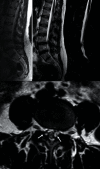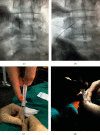An Unusual Case of Radicular Pain Caused by Bilateral Lumbar Synovial Cyst: A Case Report and Review of the Literature
- PMID: 32724694
- PMCID: PMC7382722
- DOI: 10.1155/2020/8821332
An Unusual Case of Radicular Pain Caused by Bilateral Lumbar Synovial Cyst: A Case Report and Review of the Literature
Abstract
Introduction: Spinal synovial cysts (SSCs) constitute an uncommon degenerative lesion of the spine. They are usually asymptomatic but they may also cause symptoms of variable severity. SSCs are benign growths adjoining the facet joints that may induce low back pain, lumbar radiculopathy, and neurological deficit. There are different treatment options that range from conservative management to interventions like image-guided epidural steroid injection or direct cyst puncture and finally to open or endoscopic spinal canal decompression and spinal bone fusion with/without instrumentation. A discussion of current management options for this unusual disease is presented. Material and Methods. A 52-year-old female patient presented with low back pain and left leg pain. Plain radiography demonstrated instability at the L4-L5 level. Magnetic resonance images (MRIs) revealed a bilateral cystic lesion at the L4-L5 level with associated instability and degenerative disc disease at the level L5-S1. Initially, conservative treatment was performed by aspiration of the left cyst and infiltration with corticosteroids with improvement of the pain for 1 year. After this period, the radicular and the low back pain reoccurred.
Results: Following leg pain recurrence, a hybrid L4-S1 fusion was performed. After surgery, there was clinical improvement and six months later, the patient returned to daily activities. The radiological study after five-year follow-up shows adequate implant position, without signs of loosening, compatible with solid fusion.
Conclusion: After reviewing the literature, the optimal management for patients with symptomatic lumbar synovial cyst must be very individualized, which is essential to achieve a favorable outcome.
Copyright © 2020 David Ruiz-Picazo et al.
Conflict of interest statement
The authors declare that there is no conflict of interest regarding the publication of this paper.
Figures




References
Publication types
LinkOut - more resources
Full Text Sources

